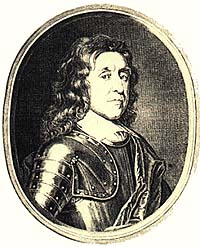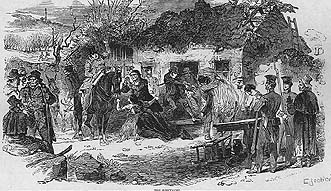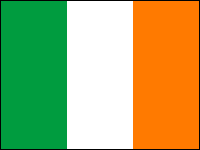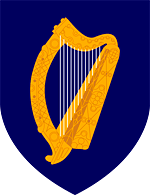| Prehistory |
|
In order to understand and appreciate the origins of the Gorman family, it
is important to view it within the context of the entire history of Ireland.
For that reason, I include this section. Ireland is like a fairy tale, and
in many respects its history makes it so. The soul of the Irish people is
a blend of many different races and cultures, and each has it’s own role in
making us who we are.
According to legend and mythology, the first inhabitants of Ireland were
the Fomorians, a supposedly misshapen race of people of unknown origin. Following
these were the Partholonians, who were, as the story goes, entirely wiped
out by a plague. The Partholonians were followed by the Nemedians, who also
were said to have died of a plague or had been driven off the island by the
Fomorians.
What is known from the archaeological evidence is that the
first inhabitants arrived in Ireland approximately 9000 years ago, about
1000 years after the end of the last ice age, in what is known as the
Mesolithic period. In all likelihood, they came from England or Scotland,
bringing with them stone-age technology and a generally hunting-gathering
way of life. During the Neolithic period, between 4000 and 2000 BC, another
group arrived, introducing agriculture, domesticated livestock, and handcrafts
such as basket making and pottery. They also began the practice of burying
their dead in large ceremonial tombs made from stone slabs, indicating
a rich spiritual life. The most active time of tomb building was during
this period. Bronze Age peoples arrived around 2000 BC, bringing with
them metalworking technology and more advanced agricultural and construction
techniques. Their tombs were characterized by long passages or chambers
lined with stones, similar to the famous tomb in Newgrange. |
| The Celts |
The next four incursions of peoples into Ireland were all of Celtic origin.
Though only loosely confederated, the Celts were one of the most powerful
nations in Europe from the 2nd millennium BC and throughout the
Greco-Roman period. Their empire encompassed most of central Europe between
the Rhine and Danube rivers. The first Celts in Ireland were the Priteni,
who arrived after 600 BC. They were followed by the Euerni (sometimes called
Firbolgs), who came from northern Gaul (now Belgium) around 500 BC. Certain
legends had it that they came from Greece, where they had been enslaved and,
having escaped in the captured ships of their masters, conquered Ireland.
The origins of the word Ireland are derived from the word Euerni (or Erin).
The Laghinians, or Tuatha De Danann, arrived from the area of Gaul that is
now Normandy and settled in Leinster (from Laighi) around 300 B.C.,
forcing the Firbolgs into the northern and western parts of the island. In
a famous battle at Southern Moytura (on the Mayo-Galway border), the Tuatha
De Danann defeated the Firbolgs to cement their dominance on the island. Unlike the Firbolgs, the Tuatha De Danann were highly civilized and
skilled in the crafts.
The fourth Celtic peoples to arrive in Ireland were the Gaodhail (or Gaedhal,
from which the word Gaelic is derived), or Milesians, named after their
fabled leader, Milish or Mile or Milesius. They arrived from Southern Gaul,
in Spain, around 150 B.C., fleeing Roman advances in that area. The Firbolgs
and Tuatha De Danann were not exterminated by the Gaodhail but were dominated
by the less numerous but more powerful Milesian aristocracy and soldiers with
superior weapons of iron. The Milesians brought the Gaelic language and soon
were intermarrying with the native peoples. According to myth, the sons of
Milesius, (H)Eber and (H)Eremon, defeated the Tuatha De Danann at the battle
of Taillte, dividing the rulership of Ireland between them, Eremon getting
the northern half of the island, Eber the south, and their brother Ir, the
northeastern corner. The latter’s name has occassionally been proposed as
an alternative source of the word Ireland - Ir’s land.
These various Celtic groups ruled Ireland throughout
the first millennium as a patchwork of more-or-less feudal states. The
country began to be heavily Christianized, starting in the early fifth
century and accelerated starting in AD 432 with the arrival of St. Patrick.
St. Patrick was a christianized slave of the Romans in Britain who brought
Christianity with him when he escaped his captors. Two centuries later,
virtually the entire island was rid of pagan religions. The Irish became
the most christianized people in Europe as the hills proliferated with
churches and monasteries. These centers of learning are often credited
with helping preserve western thought and learning through the Middle
Ages following the fall of the Roman Empire. The primary holders of this
information, the monks and abbots of the monastic orders, often carried
this knowledge to other parts of Europe. |
| The Vikings |
The Vikings arrived in Ireland in roughly AD 795, raiding shore-lying communities
in the southeast and west, finally establishing settlements, primarily in
Dublin, Waterford, Cork, Limerick, and Wexford. They continued increasing
the size of their settlements until the middle of the tenth century, first
by Vikings from Norway, and then from Denmark. Slowly, Viking culture and
the native Celtic culture intertwined but did not entirely merge. Inter-tribal
feuding continued amongst the Celtic peoples, finally culminating in the triumph
of Brian Boru as the first High King of Ireland. By the battle of Clontarf,
in AD 1014, his power had coalesced and, backed by alliances with Viking armies
from Waterford and Limerick, succeeded in the unification of the Irish tribes,
though at the cost of his own life. The following century saw the rulership
of Ireland destabilized as a result, passing between members of the O’Brien,
O’Neill, and O’Connor families.
When Rory O’Connor, king of Connacht, was challenged by an alliance of the
O’Neills, led by Muirchertach Mac Lochlainn, and Dermot MacMurrough (Diarmait
Murchadha), king of Leinster, the O’Neills once again held power in Ireland.
Following Mac Lochlainn’s death in 1166, O’Connor drove MacMurrough from Ireland.
MacMurrough, wishing to regain power, went to England, where he petitioned
the Norman King Henry II of England for assistance in regaining his territories.
He struck a bargain with Richard fitz Gilbert de Clare, earl of Pembroke (also
known as Strongbow), Robert FitzStephen, and others in exchange for land and
his daughter’s hand to Strongbow. |
| The English Take Over |
The Norman forces of Strongbow landed in 1169 and succeeded
in capturing Leinster. In 1171, Henry II landed more troops in Waterford,
initiating the long-term occupation of Ireland. By 1200, Henry and his successor,
John, had parceled out and granted pieces of the island to their nobles and
followers. Over the next two centuries, a series of English barons and governors
and a number of Irish families would rule Ireland, including the O’Neills,
O’Briens, O’Donnells, and O’Connors. A brief invasion by the Scots Edward
and Robert Bruce in 1315 to 1318 did little to change the status quo. Like
all other invaders before them, the Normans began to blend into the Irish
– speaking Irish and intermarrying, despite the issuance of the Statutes of
Kilkenny in 1366 which forbade such activities. By 1500, the area controlled
by the English crown had shrunk to a small area around Dublin known as The
Pale, with the rest of Ireland dominated by either Anglo-Irish earls or the
various Irish families in their native districts.
In 1534 Henry VIII of England began a campaign to subjugate the Irish and
bring them more under the control of the crown. He established English laws,
confiscated lands belonging to Irish and Norman lords, replaced persons in
governing positions with those loyal to him, and declared the Catholic religion,
to which most Irish belonged, unlawful. Finally, he began a policy of creating
plantations of English and Scottish natives in Ireland, especially in the
north, which would continue for the next 100 years. Henry’s successor, Elizabeth,
as well as her successor, James 1, continued Henry’s policy of handing over
Irish lands to English landowners and reducing the Irish populace to relative
serfdom. The Nine Years War, an uprising led by Hugh O’Neill in an attempt
to wrest control of Irish lands from the English, lasted from 1594 to 1603
and ended in a crushing defeat at the battle of Kinsale, despite help from
the Spanish. When O’Neill and a hundred other Irish barons fled Ireland in
1607, virtually all hope for an Irish state left with them. In their absence,
most of the lands of Ulster were confiscated and a flood of English and Scottish
Protestant settlers moved in, with the blessing of James I. Known as the "Ulster
Plantation", the results of this act can still be felt today.
The Irish rose in revolt again in 1641, led at first by
Rory O’Moore and later by Owen Roe O’Neill. They had success in forcing
the Protestant English off their lands in much of Ireland, especially
in Ulster. The fighting continued through most of the next eight years
until the arrival of Oliver Cromwell, in 1649. Sent by Charles I with
a mandate to subdue the Irish at all cost, he used whatever means necessary.
Cromwell left a path of death and destruction across Ireland not seen
there before or since. Cromwell’s scorched earth policy left, by some
estimates, between half and two-thirds of the populace of Ireland dead
over the course of the next five years, either by starvation, disease,
or wholesale executions undertaken by Cromwell and his successors. Following
this, virtually all Irish-held land was given to English Protestants.
By 1665, only twenty percent of Irish land was owned by the Irish themselves,
with less that five percent in Ulster. The Irish were not allowed to live
east of the river Shannon.
When the Catholic James II became king of England in 1685, and deposed three
years later, the Irish people had recovered sufficiently to start another
revolt, and asked James to lead them. They were defeated in 1690 at the battle
of the Boyne and later at Aughrim, ending the revolt. What followed were the
years of the "Penal Laws". Under these acts, decreed by the Treaty
of Limerick, Irish Catholics were not allowed to vote, own or lease land,
bear arms, have a profession, live in a town, or own a horse worth more than
five pounds. They were denied the rights of education, practicing their faith,
or even passing their own laws. This was followed by a famine in 1739 which
killed an estimated 400,000. Many of the penal laws remained in force until
the 1790’s.
Spurred on by successful revolts in the United States and France, the Irish
attempted once again to throw off their English yoke in 1798 and 1802. Both
were aborted attempts that never got off the ground when promised help from
France never materialized in force. The result was the Act of Union of 1801
that essentially stated that Ireland and England were a single country, with
the English parliament making laws for both countries. The Irish themselves
were not allowed to hold office in that parliament until 1829. Another insult
was the requirement that all landholders and lessors to pay a portion of their
income as tithing to the Protestant church, whether they were Protestant or
not. A stipulation in the law held that only land that was cultivated was
subject to tithing so, in effect, the wealthy English landowners became exempt.
Despite severe repression during the first half of the nineteenth
century, the population of the country exploded, nearly doubling in size
in that period to 7 million people. The populace had become dependent
on a single crop – the potato – as a means of sustenance as virtually
all others were grown for export by the landowners. The first potato blight
occurred in 1845, followed by similar blights in 1846, and 1847, all cause
by a fungus that caused the potatoes to wither and turn black in the ground.
Inaction on the part of the English government in the face of the crisis,
whether intentional or not, sealed the fate of the Irish people. An estimated
one million people died of starvation and disease as badly needed foods
like grain were exported from Ireland in an effort by the landholders
to offset the losses they incurred as a result of the declines in their
labor force. Evictions were
common, as landowners were ill-equipped to handle either the economic or
human suffering brought on by the famine. American corn of little nutritive value was imported to Ireland
and sold to the starving populace, but it was too little, too late. During
and following the famine, nearly 2 million people left Ireland for the
United States and other countries. The population of the country has never
recovered. |
| Revolution, Civil War and Independence |
The last half of the nineteenth century through the early part of the twentieth
saw Ireland attempting at least economic recovery. Primarily through political
means, many worked to have the laws changed that had put them in their predicament.
The economy had been completely shattered and would take considerable effort
to repair and some were willing to take action by more violent means. Taking
advantage of perceived weakness in the English military due to the First World
War, a number of Irish revolutionaries occupied government buildings in Dublin
on Easter Monday, April 24th 1916. The so-called "Easter Uprising"
was squashed by British forces in less than a week, but the action had galvanized
the people to the cause of nationhood. Ireland declared itself a republic
and began to set up a government. After the end of the First World War, Britain
found its army freed up and so troops and munitions began pouring into Ireland
to restore British rule. To counter this, the Irish Republican Army (IRA)
formed as a guerilla army to harass the British troops who were harassing
the Irish people.
A treaty was ratified on January 7, 1922 that gave Ireland limited autonomy
within the British Commonwealth and the county of Ulster it’s own parliament,
as a separate state. However, members of the Irish government split over terms
of the treaty, some accepting autonomy with others pushing for a full republic.
As the British army began it’s evacuation, forces for and against the treaty
took up positions in Dublin and other cities. The IRA occupied the Four Courts
building in April and was routed by pro-treaty forces soon after, completely
destroying the building and the irreplaceable records held within. Fighting
remained sporadic through the remainder of 1922 and into 1923 until an agreement
was singed in April putting an end to the fighting. A constitution was drawn
up and over the next two decades, Ireland evolved into the self-governing
republic it had desired for the previous 750 years. It became a state in 1949. |
|
|
| Images |
|

Entrance to the passage tomb at Newgrange
Donore, County Meath, constructed approximately 5000 years ago.

St. Patrick

Oliver Cromwell

Illustration of a family being evicted
From The Illustrated London
News, 1849.

Flag of the Republic of Ireland

Coat of Arms of the Republic of Ireland
Image used under the Creative Commons Attribution-Share Alike 2.5 Generic license.
|
|





